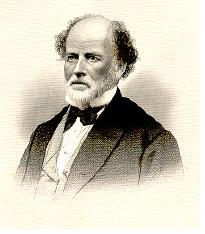Matthew Fontaine Maury
US navy officer and scientist, b. 14 January 1806 (Spotsylvania county, Virginia, USA), d. 1 February 1873 (Lexington).
 Matthew Maury was the grandson of Huguenot settlers. He entered the navy when he was 19 years old and participated in the first voyage around the world of an American vessel. In 1830 he presented a board of examiners with a solution to lunar navigation using spherical trigonometry; the solution was correct but went over the examiner's heads, who declared that Maury should better study the New American Practical Navigator by Nathaniel Bowditch, then the prescribed textbook in the navy.
Matthew Maury was the grandson of Huguenot settlers. He entered the navy when he was 19 years old and participated in the first voyage around the world of an American vessel. In 1830 he presented a board of examiners with a solution to lunar navigation using spherical trigonometry; the solution was correct but went over the examiner's heads, who declared that Maury should better study the New American Practical Navigator by Nathaniel Bowditch, then the prescribed textbook in the navy.
In 1834 Maury married, settled in Fredericksburg and began to write works on navigation and maritime matters. An article On the Navigation of Cape Horn that describes how the Cape can be passed on eastbound voyages by navigating further south to take advantage of the westerlies there appeared in the American Journal of Science and Art. A few years later Maury published A New Theoretical and Practical Treatise on Navigation. The book became the standard navy text, replacing the New American Practical Navigator on Bowditch's own recommendation.
A stagecoach accident in 1839 made him unfit for active service. In 1842 he was appointed superintendent of the Depot of Charts and Instruments, the predecessor of the U.S. Naval Observatory and Hydrographic Office. He began to issue log books to sea captains in which to enter information on winds and currents and with his 14 staff used the collected data, together with decades of old log books from the depot's archives, to prepare maps of winds and currents. The first pamphlet, Wind and Current Charts, appeared in 1847, the second, Explanations and Sailing Directions to Accompany Wind and Current Charts later simplified to Sailing Directions, in 1848.
By 1853 Maury's name was known internationally. As the representative of the USA in the first international marine conference in Brussels, which was inspired by his work, he managed to have his logbook system adopted as the international standard. The International Hydrographic Bureau, which is located in Monaco, grew out of the conference. In 1858 Maury published The Physical Geography of the Sea, the first textbook of oceanography.
When the Civil War broke out in 1861 Maury joined the Confederate States of the South as head of coast, harbour, and river defences of Virginia. He unsuccessfully tried to develop an electrical torpedo. In 1862 he went to England as a special agent of the Confederate States, and when the Confederation was defeated in 1865 he went to Mexico in an unsuccessful attempt to establish a Confederation there.
In 1868 Maury was appointed professor of meteorology at the Virginia Military Institute. Maury's birthday is a public holiday in Virginia.
Reference
The Era of Clipper Ships. http://www.eraoftheclipperships.com/page14web.html (accessed 28 April 2004)
Photo: U.S. Naval Observatory Library; public domain (US government)
home
 Matthew Maury was the grandson of Huguenot settlers. He entered the navy when he was 19 years old and participated in the first voyage around the world of an American vessel. In 1830 he presented a board of examiners with a solution to lunar navigation using spherical trigonometry; the solution was correct but went over the examiner's heads, who declared that Maury should better study the New American Practical Navigator by Nathaniel Bowditch, then the prescribed textbook in the navy.
Matthew Maury was the grandson of Huguenot settlers. He entered the navy when he was 19 years old and participated in the first voyage around the world of an American vessel. In 1830 he presented a board of examiners with a solution to lunar navigation using spherical trigonometry; the solution was correct but went over the examiner's heads, who declared that Maury should better study the New American Practical Navigator by Nathaniel Bowditch, then the prescribed textbook in the navy.